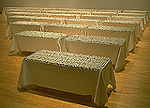ORIGINALLY PUBLISHED IN:Return to:
C MAGAZINE INTERNATIONAL
Winter, 2000-2001.

Allan McCollum.
THE EVENT:
Petrified Lightning
from Central Florida
(with supplemental
didactics). 2000.
Installation: Friedrich
Petzel Gallery.
ALLAN MCCOLLUM
at FRIEDRICH PETZEL GALLERY, NEW YORK
Multiples. Lots and lots of fulgurites. Stretching into a sea of infinity. (Or something like infinity.)
Allan McCollum never gives us just one of an object. One object can be intimate; we can get to "know it" by feeling affinities or repulsion at its texture, size, colour, function, etc. We can touch it, smell it, feel it or—in essence—notice how its objectness relates to our objectness. Instead, McCollum always give us a seemingly infinite number of objects, indiscernible from one another, displayed on walls or laid out on tables like forensic objects waiting for scientific analysis. These we cannot "get to know" in quite the same way; assimilating this vastness is not done as it is when the individual object is measurable and able to be sensuously assimilated.
In "The Event: Petrified Lightning from Central Florida (With Supplemental Didactics)," his current exhibition at the Friedrich Petzel Gallery, McCollum's choice of object is a fulgurite: not an everyday sort of object. Leaving aside the numerical issue and its associated metaphysical claims, this particular object in McCollum's exhibition needs definition: it is the corpse of an evanescent event—the crystallized formation left after lightning has struck sand. The heat from the lightning, all 50,000 degrees Fahrenheit of it, melts the sand, thereby making a sheath of glass. When extracted from the earth, some sand adheres to the sides of this natural tunnel, giving the artifact the look of a large petrified worm. From a mould of one of these, McCollum made his multiples and added to them sixty-six scientific pamphlets on the subject, some written by members of a team of scientists brought together for this project, particularly an electrical engineer and a paleontologist who helped McCollum capture the electricity (on a video that was displayed in the gallery) and extract the fulgurite. The tracts, bound in varying colours and each printed about 250 times, were also displayed as multiples, stacked about a foot high and covering the long tables that filled up an adjacent room. Density of information versus infinity of objects, and all generated by one instantaneous flash of light.
Other artists have used the multiple as a point of departure, most notably Warhol in some of his silk-screens, such as the Marilyn Monroe series. While Warhol's use of multiple images slurred the boundary between the consumable commodity and the awe-inspiring icon, McCollum treats the multiple quite differently. He sees the grandiose path from the anecdotal individual to the abstract infinite as one pitted with ridiculousness. How does the banal become the transcendent? What really happens when we go from the single object to the infinite multiple? The impressiveness of the roomful of fulgurites, all 8,000 of them lying side by side, initially registers a hush on one's sensibilities. The familiarity that comes with the physical and anecdotal qualities of the individual is gone; we "know" the infinite (if we know it at all) only abstractly—emptied of specific content. And we are left with amazement at, well—in genuine seriousness—our own smallness in the face of the void and our awe of the sublime. But McCollum is also pointing out that there is another side to the story: isn't this awe just a wee bit silly? Just because there are lots and lots of them do we really feel differently? It is the recognition of both sides of the experience that makes makes McCollum's work intelligent and interesting.
—Dena Shottenkirk
Selected texts
Return to:
MAIN